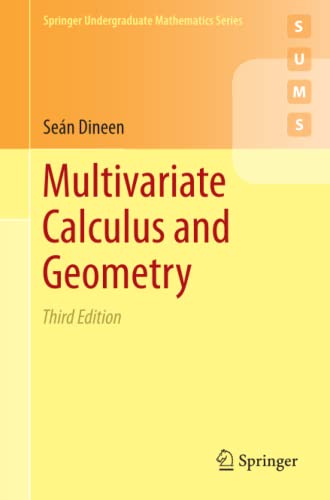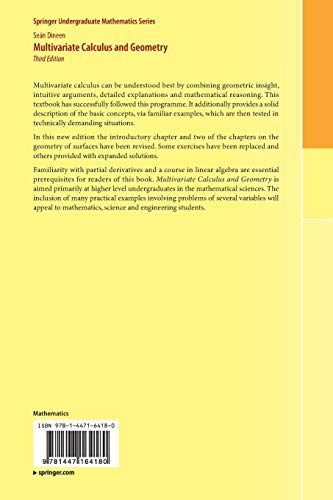



Multivariate Calculus and Geometry (Springer Undergraduate Mathematics Series)
D**
Meticulous Third-Semester Calculus with a Smooth Connection to Differential Geometry
It is shameful this lovely book has received no reviews yet. Although it is beset with the usual Springer typos and lack of editing, this book is a "must-have," not only to those who want to learn what, for most students, is typically third-semester Calculus, but also for those who are learning Differential Geometry for the first time. It is even useful for people like me who have learned Differential Geometry, but who have needed a more simple explanation that is sometimes irrecoverable from proof-laden, higher-level texts that leave you to fill in the details.Even after earning a Ph.D. in Mathematics, there are still many, many details **at the undergraduate level** that I'm constantly (and happily) surprised that I have not actually clearly connected and understood. Dineen's book - like Harold Edwards' Advanced Calculus (or second semester Analysis) text taught from the Differential Forms standpoint, makes me open my eyes to these holes in my thinking and those points that you just file away in the "I should follow up on this ..." cabinet, but never do as a graduate student.Take, for instance, his explanation in Chapter 16 of why principle curvature directions are perpendicular to each other at non-umbilic points. It's because principle curvatures are the eigenvalues of a symmetric matrix. What symmetric matrix? The one easily derivable from the relationship between the directional curvature function k_p(v) and the unit tangent directions {v| ||v||=1} at the point in question, p, on the smooth manifold. In what sense? Well, since principle curvatures (the building blocks of Gaussian curvature) are the maximum and minimum, respectively, of the curvature function, it's just the method of Lagrange multipliers applied to the curvature function k_p(v) with respect to the constraint ||v|| =1 ... These are the very functions from which the all-important l, m and n (inner product relations between the second derivatives of the position vector with the chosen normal) and E, F and G from the function representing moduli of all unit tangent vectors (i.e. the three inner products of the two first derivatives of position with respect to themselves). After setting this Lagrangian up as a matrix relationship (since the functions above are quadratic forms), and multiplying both sides by the inverse of one of these matrices (which must be invertable by definition, since the point is non-umbilic by assumption) then it is the resultant eigenvalues that are the curvatures themselves, and the associated eigenvectors that are the principle curvature directions. Sure, I should have thought of that before, but how many of us never went back to fill in these little details on our own and used the basic building blocks of simple Calculus to see things such as these clearly? Wonderful!He then hits you with minimal surfaces when you least expect it by introducing the catenoid via a rather relieving example of a solid of rotation that simplifies beautifully under the theorem relating coordinate axes to lines of curvature when F=m=0. I've never made a study of minimal surfaces and have always skipped these chapters, never being necessary for my coursework or research. Now I'm motivated to study it after he dropped it right on my head in a beautiful, physically satisfying, application-rich example.If that isn't enough, he drops in the shape operator and then does a quick rendition of Gauss-Bonnet!Though it is his Differential Geometry-themed chapters I studied most (mostly as review), namely Ch. 5, 7, 10 and 16-18, I found myself returning to the Lagrangian and optimization chapters, the chapter on surface area, and even his rendition of Stokes out of curiosity back when I first bought the book. Every chapter in this book has at least received a skim, no matter how simple, so I know his notation. It is dirty and creased from all the beatings it has taken in the hours I've given to diving into it.Is it hard? No, but you do have to kind of scratch your head and reorient yourself a bit in places, like in Chapter 16 when his notation of phi switches from the z-coordinate of the position vector to a functional representation of the position vector itself, switching notation for velocity components, etc. These are the kind of mistakes an editor could have fixed, and I would hope Dr. Dineen retools these. I also would hope to see the famous gamma notation from tensor calculus be introduced in the future since he is so close to it anyway. And why no differential forms? In a book of this caliber, adding differential forms as Thorpe did, would create an interesting Chapters 19-20 and make the book suitable for Advanced Calculus/Second-Semester Analysis courses at non-Ph.D granting colleges."Lower order" or not, this book should be on the shelves of everyone who is interested in anything from a leisurely study of geometry to potentially doing research in the subject. Along with Fortney's "Visual Introduction to Differential Forms and Manifolds," Harold Edward's "Advanced Calculus: a Differential Forms approach," Bressoud's "Second-Year Calculus" or Bachman's "Differential Forms: A Geometric Approach," you can get started in your studies of a rich and historic subject that can be of its own interest or an eventual approach to analysis or Differential Equations.In summary, there is no other book like this on the market. If you want a Differential Geometry book that you can do straight after Calculus III (though it may help to have at least Sophomore-level Linear Algebra), choose this book. It is entirely self-contained, although a second opinion on the Calculus material is always great for someone (re-)discovering the subject (Miklavcic's Illustrative guide to Multivariable and Vector Calculus, or the other Multivariable-themed S.U.M.S. text are good choices, though they lack the differential geometric option).
J**G
Five Stars
Correct description and delivery on time.Thank you.
Trustpilot
2 months ago
2 months ago